Modified Early Warning Scoring System charts should be used to aid timely recognition, treatment and referral of women who have or who are developing a critical condition. These do not take into account the physiological changes in pregnancy, however, they allow a trend in the patients’ observations to be documented and acted upon. SEE SEPSIS SCREENING TOOL BELOW

In labour changes in some parameters are highlighted in red and should be considered. Err on overdiagnosis / response if in doubt
|
Temperature <36°C or >38°C 4 In labour a temperature of ≥ 37.5°C on 2 separate occasions at least 2 hours apart |
|
Persistent tachycardia > 100bpm5 >110bpm in labour |
|
Tachypnoea >20 breaths per minute4 >22 in labour |
|
WCC <4 or >16 x 109 /L 4 WCC in labour >20 x 109 /L(although WCC of up to 30 have been seen in labour, a WCC of 20 is the generally recommended threshold for investigation in the literature)3,5 |
|
Oliguria <0.5mls/hour4 |
|
Arterial Hypoxaemia <8k Pa on air and/or metabolic acidosis pH <7.35 / H+ >45nmol/l (pregnancy results in a relative respiratory alkalosis)4 |
|
Hypotension MAP <65mmHg or systolic BP <90mmHg4 |
|
Abnormal U&Es, LFTs , Coagulation |
|
CRP – However a normal CRP may be falsely reassuring and does not rule out systemic sepsis. There is often a delay in CRP increase in acute sepsis. |
|
Fetal tachycardia and/or non reassuring CTG
|
|
Hyperglycaemia in the absence of diabetes |
The Common Organisms
The organisms most commonly implicated are2:
- Streptococcus pyogenes ( Group A strep)
- Group B streptococcus
- Escherichia coli
- Staphylococcus aureus
- Gram- positive and gram – negative mixed infections
- Streptococcus pneumoniae
- Klebsiella
- Enterococcus faecalis
- MRSA


